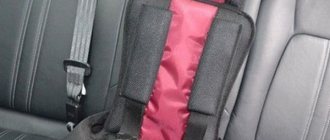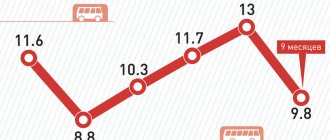Penalty for not having a child seat
The regulatory act of traffic rules, paragraph 22.9, sets out the rules that must be followed when a child is in the car, in the front or rear passenger seat.
The following standards must be observed:
- up to seven years - travel in the back and front seats and with full fixation using a cradle or car seat;
- being in a seat and secured with belts is mandatory, even for short trips;
- for children from 7 years to 12 years, and large children who do not fit in a seat can be transported without a seat only in the rear seats of the car;
- The cradle or chair is selected according to age and weight.
For violation of these rules, an administrative fine is imposed for a child without a chair - 3,000 rubles in all regions, in accordance with Article 12.23 of the Administrative Code.
For leaving a child under 7 years old in the car, the penalty amount is 2,500 rubles for residents of Moscow and St. Petersburg, and 500 rubles for other regions (Clause 1.Article 12.19 of the Administrative Code).
Classification of car seats for children depending on age category
If a minor develops slower than his peers in terms of anthropometric characteristics, then it is recommended to use class “3” seats to ensure his safety. Standard car seat belts are simply not designed for people weighing less than 35 kilograms and less than 140 centimeters tall.
What to do if a child has outgrown all standards, but is under 12? According to current legislation, parents of children over 7 years of age, at their discretion, can equip a safety seat for their child that meets the requirements of the traffic police. So, if a person has outgrown all standards according to anthropometric data, then it is recommended to transport him as an adult. And traffic police inspectors will not pay attention to a passenger if his data exceeds development standards.
The traffic police actively monitors the safety of transporting children. Child seats help reduce fatalities by two thirds. Administrative legislation provides for monetary fines for the absence of restraints and for an unbelted child in the back seat.
A child seat should be selected individually for each person, in accordance with his age, weight and height. If the driver was nevertheless subject to punishment, then he should pay the required amount as early as possible in order to receive a discount and take care of the continued safety of children in his car.
Fine for ordinary people, officials and legal entities
The fine for not having a child seat varies depending on who committed the offense:
| Responsible person | Amount of fine in rubles |
| Driver (Parents, relatives) | 3 000 |
| Officials – educators, teachers, taxi drivers | 25 000 |
| Legal entities – school, taxi company | 100 000 |
It is possible to pay the fine with a 50% discount within 20 days from the date of delivery of the decision to the citizen.
Amount of fines
Previously, a fine for not wearing a seat belt was similar to a fine for not wearing a seat belt. However, the number of fatal accidents involving children has been increasing. The cause of death in a large number of cases was the child’s position in the car not being securely fixed. So, from September 1, 2013, the fine for an unbelted child in a car is three thousand rubles .
It is also worth noting that a fine for not fastening a seat belt is imposed not only on the driver, but also on other passengers in the car with him. So, the fine for each unbelted passenger is 500 rubles . The driver himself, if he is not wearing a seat belt, is subject to a fine of 1,000 rubles, regardless of the number of passengers in the car .
Pay a fine online:
At what age should children be transported in special seats?
Transportation of children under 12 years of age must be carried out in accordance with traffic regulations (clause 22.9)
The main provisions of this regulatory legal act:
- Fixing belts and a seat are a prerequisite for transportation. Other devices, including homemade ones, cannot be used in 2021, this is noted in the traffic rules.
- In the back seat, without using a seat, but with securing belts, you can seat a child from 7 years old.
- Placing children on motorcycles is strictly prohibited.
The driver of the vehicle is also fined if:
- the minor is in the seat, but is not wearing a seat belt;
- two children were seated in one standard chair;
- the child is fastened, but is in the arms of an adult;
- the child is large and the purchased chair does not fit;
- The car is not equipped with standard securing belts.
For transporting children without a seat, a fine is imposed after drawing up a report on the offense.
If several children are traveling in a car, and all of them are without a car seat, then a standard fine is imposed - 3,000 rubles, since only one offense was recorded. You can avoid a fine when transporting children over 7 years old by using a special seat with a belt - a booster.
The inspector does not have the right to impose a penalty if the car was not moving, for example, standing in the parking lot.
Types of restraint devices
Child seats are needed for everyone under 150 cm and less than 36 kg, and are transported in the front seat. The use of a seat in the rear seat is mandatory for children under 7 years of age.
In total, there are 5 groups of child restraint devices, divided according to the child’s weight:
- Group 0 is intended for children up to 10 kg;
- Group 0+ is intended for children up to 13 kg;
- Group 1 for children from 9 kg to 18 kg;
- Group 2 for children from 15 kg to 25 kg;
- Group 3 for children from 22 kg to 36 kg.
More on the topic: What is the penalty for lowering the car and sawing off the springs?
Please note that the previously popular adapters for standard FEST belts are not child restraint devices. Since July 12, 2017, they have been effectively banned, since the license of the company producing them was taken away. Based on test results, this type of restraint is found to be unsafe for children. Thus, the inspector will quite reasonably fine the driver who is trying to replace a standard seat for transporting a child with a FEST adapter.
But boosters are allowed for use, and the inspector will not fine you for their use, but provided that the child is over 7 years old.
These devices are needed to ensure that the standard car belt passes over the chest and not over the neck of a small passenger. It will not be a big secret that for these purposes it is possible to use a regular pillow under the butt. But let us note once again that this is for older girls and boys.
As a rule, child seats are attached to the seat using standard belts, and the child is held in place by the belts of the car seat itself (ISOFIX system). If the device does not have its own belts, the child is held and secured using standard belts according to the instructions.
Taxi fine if a child is without a seat
Taxi drivers can be brought not only to administrative, but also to criminal liability under Article 238 of the Criminal Code “... provision of services that do not meet safety requirements.” However, this measure is rarely taken. Most often, both the driver and the owner of the taxi company - a legal entity - are fined.
According to administrative legislation, a driver who violates transportation rules is obliged to pay a fine of 25,000 rubles, since he is a responsible official. The director of the company pays 100,000 rubles.
If driving without a child seat causes injury to a child in a car accident, criminal proceedings are initiated. The fine under Article 238 of the Criminal Code of the Russian Federation can range from 100,000 to 500,000 rubles. The taxi service must have its own car seats for children of different ages. However, it is important to consider that if parents call a taxi without warning that there will be a child in the car, the driver has the right to refuse to provide the service.
Why is it necessary to use a child seat?
The task of every parent is to ensure the safe passage of the child in the car. The requirement for car seats was introduced for a reason: in reality, in the event of an accident, a child secured in a seat has a greater chance of surviving.
Why use a chair:
- Safe transportation of a child. Crash tests have shown that children who are not secured in a seat hit the front seat and are thrown back, resulting in life-threatening injuries.
- Safety for the driver. Because babies and teenagers are often restless, they may suddenly interfere with someone who is driving, for example by throwing a toy at them. A child fixed in a chair has limited mobility.
- Safety while playing in the car. A restrained child can do whatever he wants without slipping or hitting himself.
With the advent of car seats, many women were able to drive a car by placing the child in the front or rear seat in a restraint system. Even in the event of an accident, the child will remain secured in the cradle or seat, and most likely will not receive dangerous injuries.
Transportation of infants
A situation may arise that the baby is not in a car seat, despite the fact that it is in the car. That is, for example, his mother took him in her arms when he cried, wanted to eat, and so on. If this fact is recorded by a traffic police inspector, you will have to pay a fine for an administrative offense. Its size will also be equal to 3000 rubles.
The parents' argument that the child was born premature or has low weight is not a basis for exemption from punishment. In such situations, it is necessary to purchase adapted infant carriers that have an almost horizontal position. They are also equipped with a special insert used for moving newborns.
Important! According to traffic regulations, a special device designed to restrain a child is installed on the back seat of the car. According to statistics, the safest locations for car seats are in the middle and behind the driver. When transporting a baby, the car seat can be mounted on the front seat facing the direction of travel, but it will be necessary to turn off the front-facing airbags.
What are the downsides to car seat laws?
Most often, difficulties with the law on child seats arise in large families. One car can comfortably accommodate two, rarely three, seats, but without them all four or even five children could fit in the back seat.
Another drawback is the imposition of fines on taxi drivers. Sometimes parents deliberately do not warn that there will be a child in the cabin, so as not to increase the cost of the trip. When an inspector stops a car, the blame falls on the taxi driver. In extreme cases, the fine for parents will be 3,000 rubles, and for the driver – 25,000.
Types of chairs
Types of car seats for children on the Russian market:
| Child's age | Restraint type | Weight in kg. | Group (class) car seats |
| from birth to 1 year | Carrying or “cradle”. They are installed in the car in one of two positions: horizontal, in which the child can sleep in the car, vertical, in which the baby is held using a special belt. | to 10 | 0 |
| up to 1.5 years. Can be used for children from the first day of life. | Armchair. The child in it is in a “reclining” state. The device can be positioned either with your back or facing the direction of travel. | up to 13 | 0+ |
| from 1 year to 4 years | Armchair. Installation can only be done in the direction of travel of the vehicle. The child is secured using durable, five-point harnesses. | 9-18 | 1 |
| from 3 to 7 years | Armchair. Standard seat belt. The chair has an adjustable backrest that can be adjusted to the height of the child. | 15-25 | 2 |
| from 7 to 12 years | Seat without backrest. The child is held in place by an additional seat belt. | up to 36 | 3 |
Each type of seat is used only for children of a certain age. Some car seats, for example, categories 0 and 0+, are adjustable depending on the child’s height and weight, but from 1.5 years old it is necessary to purchase a larger seat.
Finding a child in a chair that is not suitable for him is equivalent to the absence of a device.
History of the item
When inventing a child's car seat in 1935, engineers thought about how to prevent the child from crawling around the cabin, preventing the mother from driving the car.
The first design solved exactly this problem, and did not protect the life and health of the baby. The first official document regulating child safety in a car appeared only in 1958 in Geneva. One of the first manufacturers of seat belts for children from 8 months to 6 years old was a company that specialized in the production of parachutes.
The legislative introduction of seat belts in vehicles has accelerated the development of special child restraint devices.
In 1962, the first prototypes of modern car seats appeared. Since January 1993, all child car seats in Europe have met the same standard.
When a child is naughty, it is easier for a mother to calm him down by holding him in her arms, but persuading the baby to take “his place” is a matter of dexterity and experience. At the same time, 3 thousand rubles will remain in the parents’ pocket. Having fastened the child, they will not have to be “thrown out” to pay a “useless” fine. Children quickly get used to the rules of behavior in a car and do not distract the driver from driving the vehicle. Babies fall asleep easily in a comfortable car seat.
Drivers carrying children are usually more careful and try to follow traffic rules and speed limits. Unfortunately, they are not insured against road accidents due to the fault of other, less responsible road users. In case of forced sudden maneuver (for example, emergency braking), adapted seat belts will support the child. But the main benefit of a car seat is precisely in the event of a collision - the protection of a child in a special restraint device increases by 50-80%.











